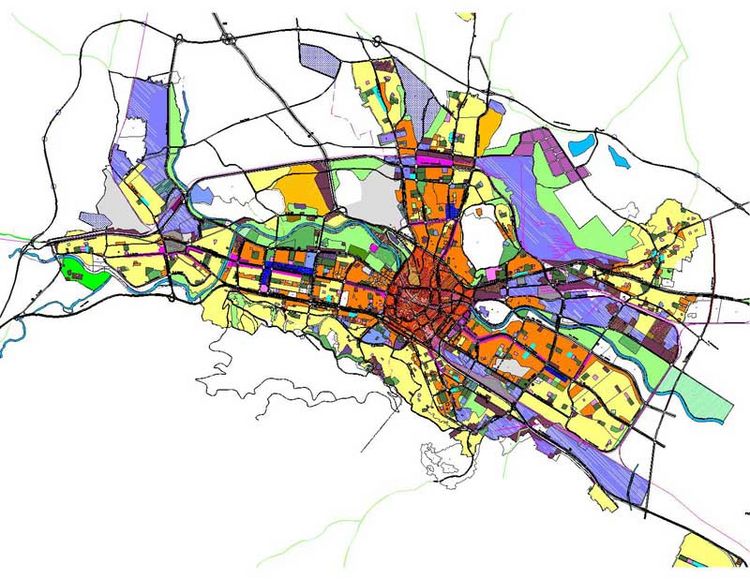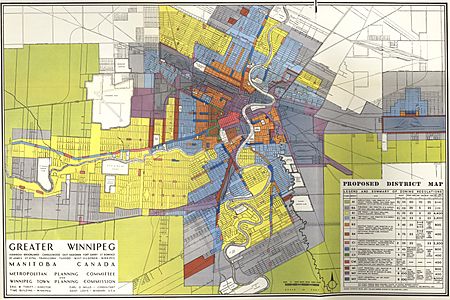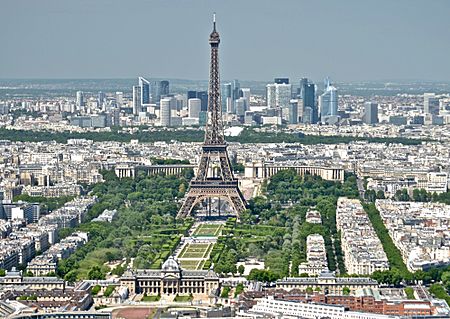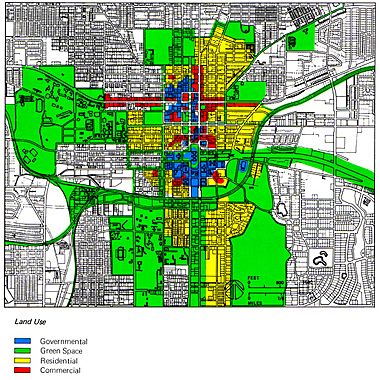Zoning facts for kids
Zoning is a way that cities and towns organize their land. Imagine dividing a big map into different areas, like drawing lines on it. Each area, called a zone, has its own rules about what kinds of buildings can be built there and what activities can happen.
For example, one zone might be only for homes, another for factories, and another for shops. These rules help guide how a city grows. They make sure that noisy factories aren't right next to quiet homes, and that there's enough space for parks and schools. Zoning is a very common way for local governments to plan their communities.

Why We Have Zoning
The main reason for zoning is to keep different types of activities separate. For instance, you wouldn't want a loud factory right next to a quiet neighborhood. Zoning also helps protect the "feel" of a community. This means keeping new buildings from changing the way an area looks or feels too much.
Zoning rules can control many things:
- What kind of activities are allowed (like homes, farms, shops, or factories).
- How many buildings can be in one area (from single houses to tall apartment buildings).
- How tall buildings can be.
- How much space buildings can take up on a piece of land.
- Where a building sits on its land (how far back from the street it is).
- How much green space or parking is needed.
Local governments, like city councils, usually control zoning. However, bigger governments (like states or countries) might set some general rules that local governments must follow. Sometimes, if a property owner faces a special problem, they can ask for a variance. This is like a small exception to the zoning rules for their specific property.
How Zoning Started
People have been organizing land for a very long time. Ancient cities often had walls, and outside the walls were the noisy or smelly activities. Inside, you'd find homes, shops, and important public buildings.
Before the Industrial Revolution (around 1760-1840), most work happened at home. So, homes were also places for making things or selling goods. This meant that different activities were often mixed together in residential areas.
But when factories started to appear, they brought lots of noise, pollution, and crowds. City leaders and planners began to think about separating these industries from where people lived. Modern zoning ideas first appeared in Germany in the late 1800s.
Different Kinds of Zoning
There are many ways to set up zoning rules. Some focus on separating different uses, while others focus on the shape and look of buildings.
Single-Use Zoning

Single-use zoning means that only one type of activity is allowed in each zone. For example, a zone might be only for homes, or only for shops, or only for factories. This type of zoning is very common in North America.
Common single-use zones include:
- Residential: For homes, from single-family houses to apartment buildings.
- Commercial: For shops, offices, and hotels.
- Industrial: For factories and warehouses.
- Special Use: For things like power plants, airports, or sports complexes.
Each of these can have smaller categories. For example, a residential zone might have different rules for single houses versus large apartment buildings.
A Look Back in Time
Even before modern zoning, some planned cities separated different uses. For instance, the city of Adelaide in Australia was designed in 1836 with a large park surrounding its center. This park helped keep the city center separate from the homes outside.
Later, in 1902, a planner named Ebenezer Howard imagined "garden cities." These cities would have separate rings for public buildings, parks, shops, homes, and factories, all surrounded by farmland.
The first city-wide zoning rules in modern times were put in place in New York City in 1916. This helped guide how the city grew over time. In cities like New York, you often see a very busy city center with tall skyscrapers, surrounded by quieter neighborhoods with homes and gardens.
Mixed-Use Zoning
Some planners, like Jane Jacobs, believed that separating everything too much wasn't good for cities. She thought that mixing homes, shops, and offices in the same area made cities more lively and safer. When more people are out and about at different times of the day, there are more "eyes on the street" to keep things safe.
Because of these ideas, many cities now have mixed-use zones. These zones allow different compatible activities to exist together. For example, you might find apartments above shops, or offices next to cafes. This helps create areas where people can live, work, and socialize without needing to drive everywhere.
Form-Based Zoning
Instead of focusing on what a building is used for, form-based zoning focuses on what it looks like and how it fits into the street. For example, it might say that buildings in a certain area need to be close to the sidewalk, have a certain height, or have windows facing the street.

New York City's 1916 zoning rules also had some form-based elements. After a very tall building called the Equitable Building blocked out sunlight for its neighbors, the city made rules about how tall buildings had to step back as they got higher. This is why many old skyscrapers in New York have that famous stepped shape.
In Paris, France, zoning rules help protect the city's historic look. They make sure that very tall office buildings are built in special areas, like La Défense, instead of tearing down old buildings in the city center.
Conditional Zoning
Conditional zoning allows for more flexibility. It means that certain uses, like a school or a community center, might be allowed in a zone where they usually wouldn't be, but only if they meet specific conditions.
For example:
- A city might allow a new grocery store in a neighborhood that doesn't have one, but only if it's built in a certain way or offers specific services.
- Community gardens might be allowed in certain zones if they follow rules about noise or hours of operation.
Pattern Zoning
Pattern zoning is a newer idea where a city provides ready-to-use building designs. If someone wants to build a house or a small shop, they can pick from these pre-approved designs. This can make it faster and easier to get building permits. It also helps create good-looking buildings that fit well into the neighborhood.
Zoning Around the World
Zoning rules are different in various countries, but they all aim to organize land use.
Australia
In Australia, each state and territory has its own zoning rules. Local governments then create more detailed plans. People can challenge decisions about zoning if they disagree.
Canada
In Canada, the provinces are in charge of land-use control. They give cities and towns the power to create their own zoning rules.
France
France has a national law called the Town Planning Code. This law guides how cities and regions plan their land. If a builder follows the rules, they can usually get permission to build.
Japan
Japan has twelve main types of zones. Each zone controls the shape of buildings and what they can be used for. Instead of strict single-use zones, Japan's system allows uses of "less intensity" in zones where "higher intensity" uses are allowed. For example, a residential zone might allow small shops, but an industrial zone would not allow schools.
| Category | What it's for |
|---|---|
| Category 1 Exclusively Low-Rise Residential Zone | Only for low-rise homes. Small shops, offices, and schools are also allowed. |
| Category 2 Exclusively Low-Rise Residential Zone | Same as Category 1, but also allows shops up to 150 square meters. |
| Category 1 Medium and High-rise oriented Residential Zone | For medium to high-rise homes. Hospitals, universities, and shops up to 500 square meters are also allowed. |
| Category 2 Medium and High-rise oriented Residential zone | Same as Category 1 Medium and High-rise, but shops and offices up to 1,500 square meters are allowed. |
| Category 1 residential zone | Mainly for homes, but also allows shops, offices, and hotels up to 3,000 square meters, and small auto repair shops. |
| Category 2 residential zone: | Same as Category 1 residential, but also allows karaoke places and has no building size limits. |
| Quasi-residential zone | Mostly for homes, but also allows vehicle-related businesses. Includes theaters, restaurants, large stores, and warehouses. |
| Neighbourhood commercial zone | For daily shopping. Same as Quasi-residential, plus auto-repair shops up to 300 square meters. |
| Commercial zone | For banks, cinemas, and department stores. Same as Neighborhood commercial, plus public bathhouses. |
| Quasi-industrial | For light industry and services. Same as Commercial, plus factories that might cause some environmental impact. |
| Industrial zone | For factories. Homes and shops can be built, but schools, hospitals, and hotels are not allowed. |
| Exclusively industrial | Only for factories. No other uses are allowed. |
Philippines
In the Philippines, the Department of Human Settlements and Urban Development (DHSUD) sets national zoning rules. Local governments then create their own detailed plans. Zones are based on what the land is mainly used for and building rules. They also include natural areas like forests and water bodies.
For example, residential zones are divided by how many homes can be in an area (low, medium, or high density). Commercial zones are also divided by how busy they are.
United Kingdom
The United Kingdom doesn't use the same "zoning" system as many other countries. Instead, local governments control all new building and changes to land use. If you want to build something new or change how a building is used, you need to get "planning permission." This permission is given based on local plans and goals for the area.
This system is more flexible. It means that local officials can decide on each building application individually, rather than just following strict zone rules.
United States

In the United States, state governments have the power to control how private land is used. The first city-wide zoning rules in the US were in New York City in 1916. The US Supreme Court said that zoning rules were legal in 1926. Interestingly, the city of Houston, Texas, is one of the few large cities in the US that doesn't have zoning laws.
There are four main types of zoning in the US:
- Euclidean Zoning: This is the most common. It separates land uses into different areas (like homes, shops, factories) and sets rules for building size and height in each area.
- Performance Zoning: This focuses on how a building or activity will affect the area, rather than just its use. It's more flexible but harder to manage.
- Incentive Zoning: This system offers rewards to builders who include things the city wants, like public spaces or affordable housing.
- Form-Based Codes: As mentioned before, these focus on the shape and look of buildings to create walkable and attractive areas.
Criticisms of Zoning
Some people argue that strict zoning laws can cause problems:
- More Driving: If homes, shops, and workplaces are too far apart, people have to drive everywhere. This leads to more traffic and pollution.
- Less Flexibility: Some critics say that single-use zoning can stop creative projects, like buildings that combine homes and shops. It can also make it harder for people to use their land for simple things like yard sales.
- Higher Housing Costs: Some studies suggest that strict zoning rules can make it harder to build new homes, which then makes housing more expensive. This can make it harder for people with lower incomes to find affordable places to live.
- Economic Inequality: Some argue that zoning laws can increase the gap between rich and poor by limiting housing options in certain areas.
However, zoning is still widely used because it helps organize cities and prevent problems like factories being built next to schools.
Images for kids
- Activity centre
- Agricultural protection zoning
- Context theory
- Ekistics
- Exclusionary zoning
- Fenceline community
- Form-based codes
- Greenspace (disambiguation)
- Open space reserve
- Urban open space
- Inclusionary zoning
- Locally unwanted land use
- Mixed use development
- New urbanism
- NIMBY
- Non-conforming use
- Planning permission
- Police power
- Principles of Intelligent Urbanism
- Reverse sensitivity
- Road
- Single-use zoning
- Spot zoning
- Statutory planning
- Subdivision (land)
- Traffic
- Variance (land use)
- YIMBY
- Zoning district
- Zoning in the United States
See also
 In Spanish: Zonificación para niños
In Spanish: Zonificación para niños


